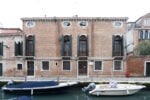IK 00. The spaces of confinement
.jpg)
Mostra collettiva
Comunicato stampa
Prisons, asylums and other correctional facilities are in constant evolution, ideologically, structurally and architecturally, encapsulating whole narrative structures of violence and resistance. How is a space of confinement produced? How can it be witnessed? In what way can it can be documented and visualised? The spatial syntax of a prison is a distorted mixture of fantasy and reality. The artists in the exhibition reflect on spaces of constraint, confinement, and containment. The functional aspects of these spaces are beyond the visible; they are distanced both spatially and temporally from the fluid existence of those on the outside. However, these places of enclosure do not exist separately from the everyday. Their construction engenders a complex set of psychological patterns that connect to the human condition of all of us.
The British philosopher and social theorist Jeremy Bentham created plans for a circular prison building he called a 'Panopticon.' Its principle, based on the hyper-visibility of the prisoners in contrast to the invisible gaze of their warden concealed within the tower, was expanded on by Michel Foucault to consider relationships between power and knowledge. The film by Harun Farocki, Prison Images, uses the documenting devices of surveillance systems themselves as his medium, together with individual electronic ankle bracelets and tracking devices, to demystify something of the interiority of both the segregated spaces of prisons and those held within them.
Other artists in the exhibition explore the body within a confined space. In Rebecca Lazier's dance research she reconstructs ritualistic repetitions of movement through a prison space while Valentin Fetisov creates a socio-psychological experience with a delusory choice of options for self-rescue. David Ter-Oganyan shifts a normal trajectory across a space by forcing the viewer to follow a convoluted route, corralled by metal barriers used for riots or crowd control.
The enclosure of the prison is often juxtaposed by its position in the landscape. Prisons often act as visually dominant reminders of colonial occupation, power structures which are present in the drawings of Conor McGrady. The hostile landscape and harsh climate of some prison locations can act as a further form of separation from a habitable world and lack of incentive to escape into it. Michael Tolmachev explores the politics of seeing and documenting, focusing on the remote territories of the 'natural' prison of the former Gulag camps, while the works of some Soviet-era camp prisoners in the form of a few surviving landscapes are both artworks and testaments of facing the invisible maximum-security walls of the landscape itself.
Arseny Zhilyaev connects a poetic imaginary world with a tragic real narrative in his work Save the Light. Canvases exposed to long periods of sunlight shining through a prison window, supposedly made by a fictional protagonist in the form of a Russian avant-garde poet and artist who spent 20 years in a Stalinist Gulag, are linked to the case of an activist arrested in 2012 during mass riots in Moscow whose eyesight was decreasing drastically in the pre-detention prison where he had been held.
The exhibition will take place on Giudecca island in Venice where a womens' prison, an integral part of the local community's life, is located in the immediate neighbourhood of the venue. Rossella Biscotti has collected a number of dream memories from some of the women, and has created an audio installation that is spread out around the exhibition.
Participating artists: Rossella Biscotti, Sam Durant, Harun Farocki, Valentin Fetisov, Ashley Hunt, Rebecca Lazier, Conor McGrady, Mikhail Nesterov, Markus Schinwald, Jonas Staal, David Ter-Oganyan, Michael Tolmachev, Ines & Eyal Weizman, Donovan Wylie, Urban Fauna Lab, Arseniy Zhilyaev



